1 为什么要使用关联
模型之间为什么要有关联?因为关联让常规操作更简单。例如,在一个简单的 Rails 程序中,有一个顾客模型和一个订单模型。每个顾客可以下多个订单。没用关联的模型定义如下:
class Customer < ActiveRecord::Base end class Order < ActiveRecord::Base end
假如我们要为一个顾客添加一个订单,得这么做:
@order = Order.create(order_date: Time.now, customer_id: @customer.id)
或者说要删除一个顾客,确保他的所有订单都会被删除,得这么做:
@orders = Order.where(customer_id: @customer.id) @orders.each do |order| order.destroy end @customer.destroy
使用 Active Record 关联,告诉 Rails 这两个模型是有一定联系的,就可以把这些操作连在一起。下面使用关联重新定义顾客和订单模型:
class Customer < ActiveRecord::Base has_many :orders, dependent: :destroy end class Order < ActiveRecord::Base belongs_to :customer end
这么修改之后,为某个顾客添加新订单就变得简单了:
@order = @customer.orders.create(order_date: Time.now)
删除顾客及其所有订单更容易:
@customer.destroy
学习更多关联类型,请阅读下一节。下一节介绍了一些使用关联时的小技巧,然后列出了关联添加的所有方法和选项。
2 关联的类型
在 Rails 中,关联是两个 Active Record 模型之间的关系。关联使用宏的方式实现,用声明的形式为模型添加功能。例如,声明一个模型属于(belongs_to)另一个模型后,Rails 会维护两个模型之间的“主键-外键”关系,而且还向模型中添加了很多实用的方法。Rails 支持六种关联:
belongs_tohas_onehas_manyhas_many :throughhas_one :throughhas_and_belongs_to_many
在后面的几节中,你会学到如何声明并使用这些关联。首先来看一下各种关联适用的场景。
2.1 belongs_to 关联
belongs_to 关联创建两个模型之间一对一的关系,声明所在的模型实例属于另一个模型的实例。例如,如果程序中有顾客和订单两个模型,每个订单只能指定给一个顾客,就要这么声明订单模型:
class Order < ActiveRecord::Base belongs_to :customer end
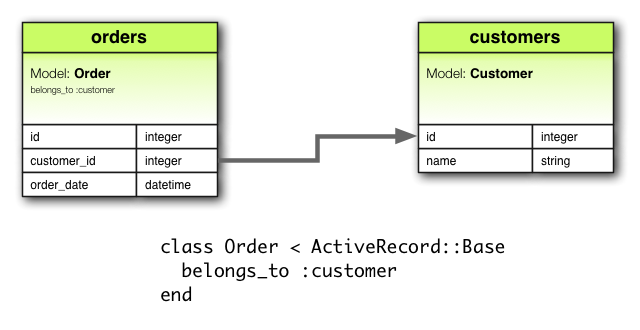
在 belongs_to 关联声明中必须使用单数形式。如果在上面的代码中使用复数形式,程序会报错,提示未初始化常量 Order::Customers。因为 Rails 自动使用关联中的名字引用类名。如果关联中的名字错误的使用复数,引用的类也就变成了复数。
相应的迁移如下:
class CreateOrders < ActiveRecord::Migration
def change
create_table :customers do |t|
t.string :name
t.timestamps
end
create_table :orders do |t|
t.belongs_to :customer
t.datetime :order_date
t.timestamps
end
end
end
2.2 has_one 关联
has_one 关联也会建立两个模型之间的一对一关系,但语义和结果有点不一样。这种关联表示模型的实例包含或拥有另一个模型的实例。例如,在程序中,每个供应商只有一个账户,可以这么定义供应商模型:
class Supplier < ActiveRecord::Base has_one :account end
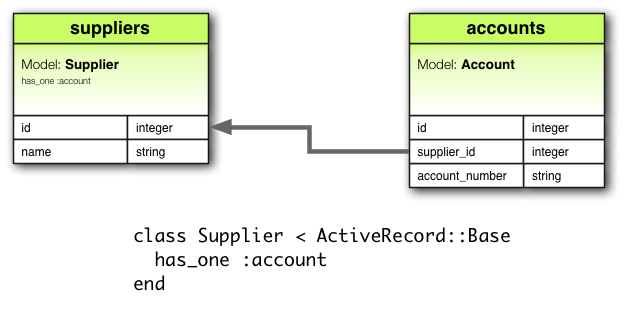
相应的迁移如下:
class CreateSuppliers < ActiveRecord::Migration
def change
create_table :suppliers do |t|
t.string :name
t.timestamps
end
create_table :accounts do |t|
t.belongs_to :supplier
t.string :account_number
t.timestamps
end
end
end
2.3 has_many 关联
has_many 关联建立两个模型之间的一对多关系。在 belongs_to 关联的另一端经常会使用这个关联。has_many 关联表示模型的实例有零个或多个另一个模型的实例。例如,在程序中有顾客和订单两个模型,顾客模型可以这么定义:
class Customer < ActiveRecord::Base has_many :orders end
声明 has_many 关联时,另一个模型使用复数形式。
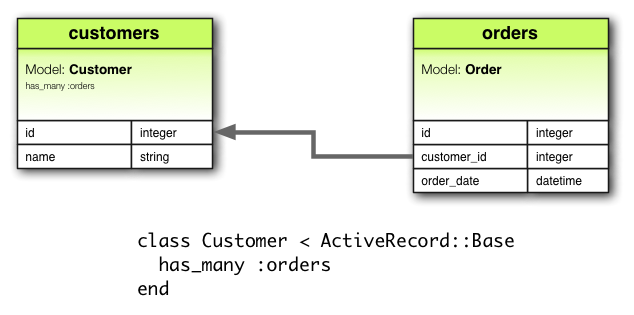
相应的迁移如下:
class CreateCustomers < ActiveRecord::Migration
def change
create_table :customers do |t|
t.string :name
t.timestamps
end
create_table :orders do |t|
t.belongs_to :customer
t.datetime :order_date
t.timestamps
end
end
end
2.4 has_many :through 关联
has_many :through 关联经常用来建立两个模型之间的多对多关联。这种关联表示一个模型的实例可以借由第三个模型,拥有零个和多个另一个模型的实例。例如,在看病过程中,病人要和医生预约时间。这中间的关联声明如下:
class Physician < ActiveRecord::Base has_many :appointments has_many :patients, through: :appointments end class Appointment < ActiveRecord::Base belongs_to :physician belongs_to :patient end class Patient < ActiveRecord::Base has_many :appointments has_many :physicians, through: :appointments end
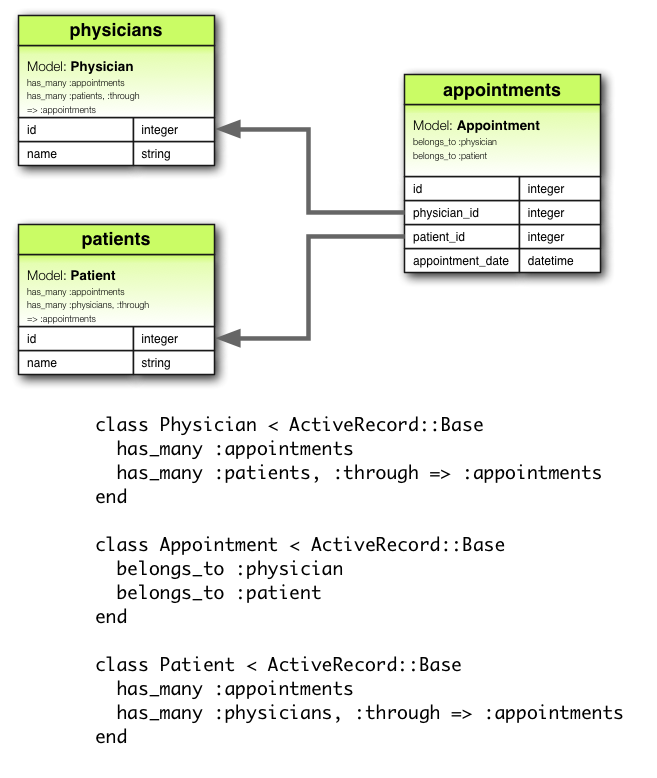
相应的迁移如下:
class CreateAppointments < ActiveRecord::Migration
def change
create_table :physicians do |t|
t.string :name
t.timestamps
end
create_table :patients do |t|
t.string :name
t.timestamps
end
create_table :appointments do |t|
t.belongs_to :physician
t.belongs_to :patient
t.datetime :appointment_date
t.timestamps
end
end
end
连接模型中的集合可以使用 API 关联。例如:
physician.patients = patients
会为新建立的关联对象创建连接模型实例,如果其中一个对象删除了,相应的记录也会删除。
自动删除连接模型的操作直接执行,不会触发 *_destroy 回调。
has_many :through 还可用来简化嵌套的 has_many 关联。例如,一个文档分为多个部分,每一部分又有多个段落,如果想使用简单的方式获取文档中的所有段落,可以这么做:
class Document < ActiveRecord::Base has_many :sections has_many :paragraphs, through: :sections end class Section < ActiveRecord::Base belongs_to :document has_many :paragraphs end class Paragraph < ActiveRecord::Base belongs_to :section end
加上 through: :sections 后,Rails 就能理解这段代码:
@document.paragraphs
2.5 has_one :through 关联
has_one :through 关联建立两个模型之间的一对一关系。这种关联表示一个模型通过第三个模型拥有另一个模型的实例。例如,每个供应商只有一个账户,而且每个账户都有一个历史账户,那么可以这么定义模型:
class Supplier < ActiveRecord::Base has_one :account has_one :account_history, through: :account end class Account < ActiveRecord::Base belongs_to :supplier has_one :account_history end class AccountHistory < ActiveRecord::Base belongs_to :account end
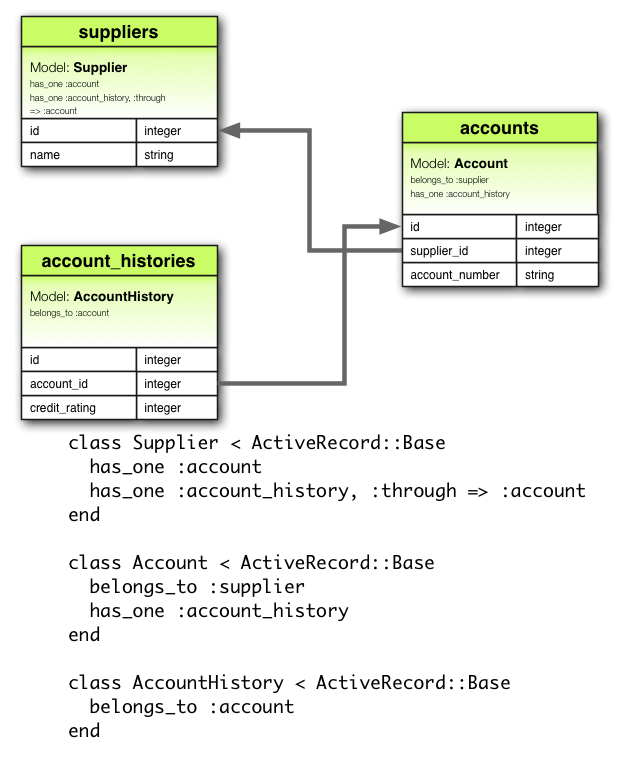
相应的迁移如下:
class CreateAccountHistories < ActiveRecord::Migration
def change
create_table :suppliers do |t|
t.string :name
t.timestamps
end
create_table :accounts do |t|
t.belongs_to :supplier
t.string :account_number
t.timestamps
end
create_table :account_histories do |t|
t.belongs_to :account
t.integer :credit_rating
t.timestamps
end
end
end
2.6 has_and_belongs_to_many 关联
has_and_belongs_to_many 关联之间建立两个模型之间的多对多关系,不借由第三个模型。例如,程序中有装配体和零件两个模型,每个装配体中有多个零件,每个零件又可用于多个装配体,这时可以按照下面的方式定义模型:
class Assembly < ActiveRecord::Base has_and_belongs_to_many :parts end class Part < ActiveRecord::Base has_and_belongs_to_many :assemblies end
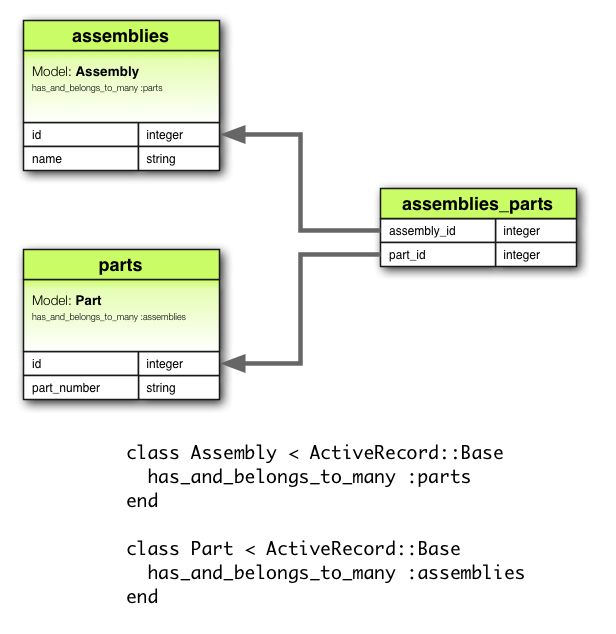
相应的迁移如下:
class CreateAssembliesAndParts < ActiveRecord::Migration
def change
create_table :assemblies do |t|
t.string :name
t.timestamps
end
create_table :parts do |t|
t.string :part_number
t.timestamps
end
create_table :assemblies_parts, id: false do |t|
t.belongs_to :assembly
t.belongs_to :part
end
end
end
2.7 使用 belongs_to 还是 has_one
如果想建立两个模型之间的一对一关系,可以在一个模型中声明 belongs_to,然后在另一模型中声明 has_one。但是怎么知道在哪个模型中声明哪种关联?
不同的声明方式带来的区别是外键放在哪个模型对应的数据表中(外键在声明 belongs_to 关联所在模型对应的数据表中)。不过声明时要考虑一下语义,has_one 的意思是某样东西属于我。例如,说供应商有一个账户,比账户拥有供应商更合理,所以正确的关联应该这么声明:
class Supplier < ActiveRecord::Base has_one :account end class Account < ActiveRecord::Base belongs_to :supplier end
相应的迁移如下:
class CreateSuppliers < ActiveRecord::Migration
def change
create_table :suppliers do |t|
t.string :name
t.timestamps
end
create_table :accounts do |t|
t.integer :supplier_id
t.string :account_number
t.timestamps
end
end
end
t.integer :supplier_id 更明确的表明了外键的名字。在目前的 Rails 版本中,可以抽象实现的细节,使用 t.references :supplier 代替。
2.8 使用 has_many :through 还是 has_and_belongs_to_many
Rails 提供了两种建立模型之间多对多关系的方法。其中比较简单的是 has_and_belongs_to_many,可以直接建立关联:
class Assembly < ActiveRecord::Base has_and_belongs_to_many :parts end class Part < ActiveRecord::Base has_and_belongs_to_many :assemblies end
第二种方法是使用 has_many :through,但无法直接建立关联,要通过第三个模型:
class Assembly < ActiveRecord::Base has_many :manifests has_many :parts, through: :manifests end class Manifest < ActiveRecord::Base belongs_to :assembly belongs_to :part end class Part < ActiveRecord::Base has_many :manifests has_many :assemblies, through: :manifests end
根据经验,如果关联的第三个模型要作为独立实体使用,要用 has_many :through 关联;如果不需要使用第三个模型,用简单的 has_and_belongs_to_many 关联即可(不过要记得在数据库中创建连接数据表)。
如果需要做数据验证、回调,或者连接模型上要用到其他属性,此时就要使用 has_many :through 关联。
2.9 多态关联
关联还有一种高级用法,“多态关联”。在多态关联中,在同一个关联中,模型可以属于其他多个模型。例如,图片模型可以属于雇员模型或者产品模型,模型的定义如下:
class Picture < ActiveRecord::Base belongs_to :imageable, polymorphic: true end class Employee < ActiveRecord::Base has_many :pictures, as: :imageable end class Product < ActiveRecord::Base has_many :pictures, as: :imageable end
在 belongs_to 中指定使用多态,可以理解成创建了一个接口,可供任何一个模型使用。在 Employee 模型实例上,可以使用 @employee.pictures 获取图片集合。类似地,可使用 @product.pictures 获取产品的图片。
在 Picture 模型的实例上,可以使用 @picture.imageable 获取父对象。不过事先要在声明多态接口的模型中创建外键字段和类型字段:
class CreatePictures < ActiveRecord::Migration
def change
create_table :pictures do |t|
t.string :name
t.integer :imageable_id
t.string :imageable_type
t.timestamps
end
end
end
上面的迁移可以使用 t.references 简化:
class CreatePictures < ActiveRecord::Migration
def change
create_table :pictures do |t|
t.string :name
t.references :imageable, polymorphic: true
t.timestamps
end
end
end
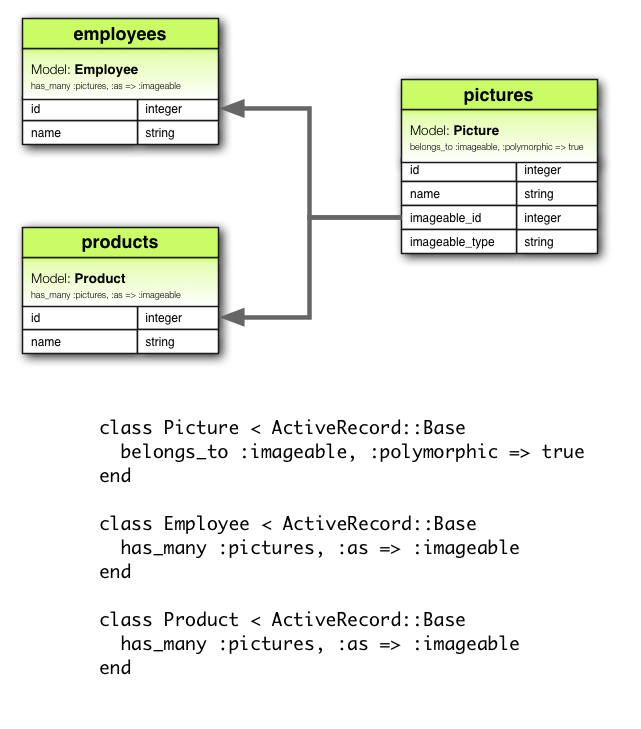
2.10 自连接
设计数据模型时会发现,有时模型要和自己建立关联。例如,在一个数据表中保存所有雇员的信息,但要建立经理和下属之间的关系。这种情况可以使用自连接关联解决:
class Employee < ActiveRecord::Base
has_many :subordinates, class_name: "Employee",
foreign_key: "manager_id"
belongs_to :manager, class_name: "Employee"
end
这样定义模型后,就可以使用 @employee.subordinates 和 @employee.manager 了。
在迁移中,要添加一个引用字段,指向模型自身:
class CreateEmployees < ActiveRecord::Migration
def change
create_table :employees do |t|
t.references :manager
t.timestamps
end
end
end
3 小技巧和注意事项
在 Rails 程序中高效地使用 Active Record 关联,要了解以下几个知识:
- 缓存控制
- 避免命名冲突
- 更新模式
- 控制关联的作用域
- Bi-directional associations
3.1 缓存控制
关联添加的方法都会使用缓存,记录最近一次查询结果,以备后用。缓存还会在方法之间共享。例如:
customer.orders # retrieves orders from the database customer.orders.size # uses the cached copy of orders customer.orders.empty? # uses the cached copy of orders
程序的其他部分会修改数据,那么应该怎么重载缓存呢?调用关联方法时传入 true 参数即可:
customer.orders # retrieves orders from the database
customer.orders.size # uses the cached copy of orders
customer.orders(true).empty? # discards the cached copy of orders
# and goes back to the database
3.2 避免命名冲突
关联的名字并不能随意使用。因为创建关联时,会向模型添加同名方法,所以关联的名字不能和 ActiveRecord::Base 中的实例方法同名。如果同名,关联方法会覆盖 ActiveRecord::Base 中的实例方法,导致错误。例如,关联的名字不能为 attributes 或 connection。
3.3 更新模式
关联非常有用,但没什么魔法。关联对应的数据库模式需要你自己编写。不同的关联类型,要做的事也不同。对 belongs_to 关联来说,要创建外键;对 has_and_belongs_to_many 来说,要创建相应的连接数据表。
3.3.1 创建 belongs_to 关联所需的外键
声明 belongs_to 关联后,要创建相应的外键。例如,有下面这个模型:
class Order < ActiveRecord::Base belongs_to :customer end
这种关联需要在数据表中创建合适的外键:
class CreateOrders < ActiveRecord::Migration
def change
create_table :orders do |t|
t.datetime :order_date
t.string :order_number
t.integer :customer_id
end
end
end
如果声明关联之前已经定义了模型,则要在迁移中使用 add_column 创建外键。
3.3.2 创建 has_and_belongs_to_many 关联所需的连接数据表
声明 has_and_belongs_to_many 关联后,必须手动创建连接数据表。除非在 :join_table 选项中指定了连接数据表的名字,否则 Active Record 会按照类名出现在字典中的顺序为数据表起名字。那么,顾客和订单模型使用的连接数据表默认名为“customers_orders”,因为在字典中,“c”在“o”前面。
模型名的顺序使用字符串的 < 操作符确定。所以,如果两个字符串的长度不同,比较最短长度时,两个字符串是相等的,但长字符串的排序比短字符串靠前。例如,你可能以为“"paper_boxes”和“papers”这两个表生成的连接表名为“papers_paper_boxes”,因为“paper_boxes”比“papers”长。其实生成的连接表名为“paper_boxes_papers”,因为在一般的编码方式中,“_”比“s”靠前。
不管名字是什么,你都要在迁移中手动创建连接数据表。例如下面的关联声明:
class Assembly < ActiveRecord::Base has_and_belongs_to_many :parts end class Part < ActiveRecord::Base has_and_belongs_to_many :assemblies end
需要在迁移中创建 assemblies_parts 数据表,而且该表无主键:
class CreateAssembliesPartsJoinTable < ActiveRecord::Migration
def change
create_table :assemblies_parts, id: false do |t|
t.integer :assembly_id
t.integer :part_id
end
end
end
我们把 id: false 选项传给 create_table 方法,因为这个表不对应模型。只有这样,关联才能正常建立。如果在使用 has_and_belongs_to_many 关联时遇到奇怪的表现,例如提示模型 ID 损坏,或 ID 冲突,有可能就是因为创建了主键。
3.4 控制关联的作用域
默认情况下,关联只会查找当前模块作用域中的对象。如果在模块中定义 Active Record 模型,知道这一点很重要。例如:
module MyApplication
module Business
class Supplier < ActiveRecord::Base
has_one :account
end
class Account < ActiveRecord::Base
belongs_to :supplier
end
end
end
上面的代码能正常运行,因为 Supplier 和 Account 在同一个作用域内。但下面这段代码就不行了,因为 Supplier 和 Account 在不同的作用域中:
module MyApplication
module Business
class Supplier < ActiveRecord::Base
has_one :account
end
end
module Billing
class Account < ActiveRecord::Base
belongs_to :supplier
end
end
end
要想让处在不同命名空间中的模型正常建立关联,声明关联时要指定完整的类名:
module MyApplication
module Business
class Supplier < ActiveRecord::Base
has_one :account,
class_name: "MyApplication::Billing::Account"
end
end
module Billing
class Account < ActiveRecord::Base
belongs_to :supplier,
class_name: "MyApplication::Business::Supplier"
end
end
end
3.5 双向关联
一般情况下,都要求能在关联的两端进行操作。例如,有下面的关联声明:
class Customer < ActiveRecord::Base has_many :orders end class Order < ActiveRecord::Base belongs_to :customer end
默认情况下,Active Record 并不知道这个关联中两个模型之间的联系。可能导致同一对象的两个副本不同步:
c = Customer.first o = c.orders.first c.first_name == o.customer.first_name # => true c.first_name = 'Manny' c.first_name == o.customer.first_name # => false
之所以会发生这种情况,是因为 c 和 o.customer 在内存中是同一数据的两种表示,修改其中一个并不会刷新另一个。Active Record 提供了 :inverse_of 选项,可以告知 Rails 两者之间的关系:
class Customer < ActiveRecord::Base has_many :orders, inverse_of: :customer end class Order < ActiveRecord::Base belongs_to :customer, inverse_of: :orders end
这么修改之后,Active Record 就只会加载一个顾客对象,避免数据的不一致性,提高程序的执行效率:
c = Customer.first o = c.orders.first c.first_name == o.customer.first_name # => true c.first_name = 'Manny' c.first_name == o.customer.first_name # => true
inverse_of 有些限制:
- 不能和
:through选项同时使用; - 不能和
:polymorphic选项同时使用; - 不能和
:as选项同时使用; - 在
belongs_to关联中,会忽略has_many关联的inverse_of选项;
每种关联都会尝试自动找到关联的另一端,设置 :inverse_of 选项(根据关联的名字)。使用标准名字的关联都有这种功能。但是,如果在关联中设置了下面这些选项,将无法自动设置 :inverse_of:
:conditions:through:polymorphic:foreign_key
4 关联详解
下面几节详细说明各种关联,包括添加的方法和声明关联时可以使用的选项。
4.1 belongs_to 关联详解
belongs_to 关联创建一个模型与另一个模型之间的一对一关系。用数据库的行话来说,就是这个类中包含了外键。如果外键在另一个类中,就应该使用 has_one 关联。
4.1.1 belongs_to 关联添加的方法
声明 belongs_to 关联后,所在的类自动获得了五个和关联相关的方法:
association(force_reload = false)association=(associate)build_association(attributes = {})create_association(attributes = {})create_association!(attributes = {})
这五个方法中的 association 要替换成传入 belongs_to 方法的第一个参数。例如,如下的声明:
class Order < ActiveRecord::Base belongs_to :customer end
每个 Order 模型实例都获得了这些方法:
customer customer= build_customer create_customer create_customer!
在 has_one 和 belongs_to 关联中,必须使用 build_* 方法构建关联对象。association.build 方法是在 has_many 和 has_and_belongs_to_many 关联中使用的。创建关联对象要使用 create_* 方法。
4.1.1.1 association(force_reload = false)
如果关联的对象存在,association 方法会返回关联对象。如果找不到关联对象,则返回 nil。
@customer = @order.customer
如果关联对象之前已经取回,会返回缓存版本。如果不想使用缓存版本,强制重新从数据库中读取,可以把 force_reload 参数设为 true。
4.1.1.2 association=(associate)
association= 方法用来赋值关联的对象。这个方法的底层操作是,从关联对象上读取主键,然后把值赋给该主键对应的对象。
@order.customer = @customer
4.1.1.3 build_association(attributes = {})
build_association 方法返回该关联类型的一个新对象。这个对象使用传入的属性初始化,和对象连接的外键会自动设置,但关联对象不会存入数据库。
@customer = @order.build_customer(customer_number: 123,
customer_name: "John Doe")
4.1.1.4 create_association(attributes = {})
create_association 方法返回该关联类型的一个新对象。这个对象使用传入的属性初始化,和对象连接的外键会自动设置,只要能通过所有数据验证,就会把关联对象存入数据库。
@customer = @order.create_customer(customer_number: 123,
customer_name: "John Doe")
4.1.1.5 create_association!(attributes = {})
和 create_association 方法作用相同,但是如果记录不合法,会抛出 ActiveRecord::RecordInvalid 异常。
4.1.2 belongs_to 方法的选项
Rails 的默认设置足够智能,能满足常见需求。但有时还是需要定制 belongs_to 关联的行为。定制的方法很简单,声明关联时传入选项或者使用代码块即可。例如,下面的关联使用了两个选项:
class Order < ActiveRecord::Base
belongs_to :customer, dependent: :destroy,
counter_cache: true
end
belongs_to 关联支持以下选项:
:autosave:class_name:counter_cache:dependent:foreign_key:inverse_of:polymorphic:touch:validate
4.1.2.1 :autosave
如果把 :autosave 选项设为 true,保存父对象时,会自动保存所有子对象,并把标记为析构的子对象销毁。
4.1.2.2 :class_name
如果另一个模型无法从关联的名字获取,可以使用 :class_name 选项指定模型名。例如,如果订单属于顾客,但表示顾客的模型是 Patron,就可以这样声明关联:
class Order < ActiveRecord::Base belongs_to :customer, class_name: "Patron" end
4.1.2.3 :counter_cache
:counter_cache 选项可以提高统计所属对象数量操作的效率。假如如下的模型:
class Order < ActiveRecord::Base belongs_to :customer end class Customer < ActiveRecord::Base has_many :orders end
这样声明关联后,如果想知道 @customer.orders.size 的结果,就要在数据库中执行 COUNT(*) 查询。如果不想执行这个查询,可以在声明 belongs_to 关联的模型中加入计数缓存功能:
class Order < ActiveRecord::Base belongs_to :customer, counter_cache: true end class Customer < ActiveRecord::Base has_many :orders end
这样声明关联后,Rails 会及时更新缓存,调用 size 方法时返回缓存中的值。
虽然 :counter_cache 选项在声明 belongs_to 关联的模型中设置,但实际使用的字段要添加到关联的模型中。针对上面的例子,要把 orders_count 字段加入 Customer 模型。这个字段的默认名也是可以设置的:
class Order < ActiveRecord::Base belongs_to :customer, counter_cache: :count_of_orders end class Customer < ActiveRecord::Base has_many :orders end
计数缓存字段通过 attr_readonly 方法加入关联模型的只读属性列表中。
4.1.2.4 :dependent
:dependent 选项的值有两个:
-
:destroy:销毁对象时,也会在关联对象上调用destroy方法; -
:delete:销毁对象时,关联的对象不会调用destroy方法,而是直接从数据库中删除;
在 belongs_to 关联和 has_many 关联配对时,不应该设置这个选项,否则会导致数据库中出现孤儿记录。
4.1.2.5 :foreign_key
按照约定,用来存储外键的字段名是关联名后加 _id。:foreign_key 选项可以设置要使用的外键名:
class Order < ActiveRecord::Base
belongs_to :customer, class_name: "Patron",
foreign_key: "patron_id"
end
不管怎样,Rails 都不会自动创建外键字段,你要自己在迁移中创建。
4.1.2.6 :inverse_of
:inverse_of 选项指定 belongs_to 关联另一端的 has_many 和 has_one 关联名。不能和 :polymorphic 选项一起使用。
class Customer < ActiveRecord::Base has_many :orders, inverse_of: :customer end class Order < ActiveRecord::Base belongs_to :customer, inverse_of: :orders end
4.1.2.7 :polymorphic
:polymorphic 选项为 true 时表明这是个多态关联。前文已经详细介绍过多态关联。
4.1.2.8 :touch
如果把 :touch 选项设为 true,保存或销毁对象时,关联对象的 updated_at 或 updated_on 字段会自动设为当前时间戳。
class Order < ActiveRecord::Base belongs_to :customer, touch: true end class Customer < ActiveRecord::Base has_many :orders end
在这个例子中,保存或销毁订单后,会更新关联的顾客中的时间戳。还可指定要更新哪个字段的时间戳:
class Order < ActiveRecord::Base belongs_to :customer, touch: :orders_updated_at end
4.1.2.9 :validate
如果把 :validate 选项设为 true,保存对象时,会同时验证关联对象。该选项的默认值是 false,保存对象时不验证关联对象。
4.1.3 belongs_to 的作用域
有时可能需要定制 belongs_to 关联使用的查询方式,定制的查询可在作用域代码块中指定。例如:
class Order < ActiveRecord::Base
belongs_to :customer, -> { where active: true },
dependent: :destroy
end
在作用域代码块中可以使用任何一个标准的查询方法。下面分别介绍这几个方法:
whereincludesreadonlyselect
4.1.3.1 where
where 方法指定关联对象必须满足的条件。
class Order < ActiveRecord::Base
belongs_to :customer, -> { where active: true }
end
4.1.3.2 includes
includes 方法指定使用关联时要按需加载的间接关联。例如,有如下的模型:
class LineItem < ActiveRecord::Base belongs_to :order end class Order < ActiveRecord::Base belongs_to :customer has_many :line_items end class Customer < ActiveRecord::Base has_many :orders end
如果经常要直接从商品上获取顾客对象(@line_item.order.customer),就可以把顾客引入商品和订单的关联中:
class LineItem < ActiveRecord::Base
belongs_to :order, -> { includes :customer }
end
class Order < ActiveRecord::Base
belongs_to :customer
has_many :line_items
end
class Customer < ActiveRecord::Base
has_many :orders
end
直接关联没必要使用 includes。如果 Order belongs_to :customer,那么顾客会自动按需加载。
4.1.3.3 readonly
如果使用 readonly,通过关联获取的对象就是只读的。
4.1.3.4 select
select 方法会覆盖获取关联对象使用的 SQL SELECT 子句。默认情况下,Rails 会读取所有字段。
如果在 belongs_to 关联中使用 select 方法,应该同时设置 :foreign_key 选项,确保返回正确的结果。
4.1.4 检查关联的对象是否存在
检查关联的对象是否存在可以使用 association.nil? 方法:
if @order.customer.nil? @msg = "No customer found for this order" end
4.1.5 什么时候保存对象
把对象赋值给 belongs_to 关联不会自动保存对象,也不会保存关联的对象。
4.2 has_one 关联详解
has_one 关联建立两个模型之间的一对一关系。用数据库的行话说,这种关联的意思是外键在另一个类中。如果外键在这个类中,应该使用 belongs_to 关联。
4.2.1 has_one 关联添加的方法
声明 has_one 关联后,声明所在的类自动获得了五个关联相关的方法:
association(force_reload = false)association=(associate)build_association(attributes = {})create_association(attributes = {})create_association!(attributes = {})
这五个方法中的 association 要替换成传入 has_one 方法的第一个参数。例如,如下的声明:
class Supplier < ActiveRecord::Base has_one :account end
每个 Supplier 模型实例都获得了这些方法:
account account= build_account create_account create_account!
在 has_one 和 belongs_to 关联中,必须使用 build_* 方法构建关联对象。association.build 方法是在 has_many 和 has_and_belongs_to_many 关联中使用的。创建关联对象要使用 create_* 方法。
4.2.1.1 association(force_reload = false)
如果关联的对象存在,association 方法会返回关联对象。如果找不到关联对象,则返回 nil。
@account = @supplier.account
如果关联对象之前已经取回,会返回缓存版本。如果不想使用缓存版本,强制重新从数据库中读取,可以把 force_reload 参数设为 true。
4.2.1.2 association=(associate)
association= 方法用来赋值关联的对象。这个方法的底层操作是,从关联对象上读取主键,然后把值赋给该主键对应的关联对象。
@supplier.account = @account
4.2.1.3 build_association(attributes = {})
build_association 方法返回该关联类型的一个新对象。这个对象使用传入的属性初始化,和对象连接的外键会自动设置,但关联对象不会存入数据库。
@account = @supplier.build_account(terms: "Net 30")
4.2.1.4 create_association(attributes = {})
create_association 方法返回该关联类型的一个新对象。这个对象使用传入的属性初始化,和对象连接的外键会自动设置,只要能通过所有数据验证,就会把关联对象存入数据库。
@account = @supplier.create_account(terms: "Net 30")
4.2.1.5 create_association!(attributes = {})
和 create_association 方法作用相同,但是如果记录不合法,会抛出 ActiveRecord::RecordInvalid 异常。
4.2.2 has_one 方法的选项
Rails 的默认设置足够智能,能满足常见需求。但有时还是需要定制 has_one 关联的行为。定制的方法很简单,声明关联时传入选项即可。例如,下面的关联使用了两个选项:
class Supplier < ActiveRecord::Base has_one :account, class_name: "Billing", dependent: :nullify end
has_one 关联支持以下选项:
:as:autosave:class_name:dependent:foreign_key:inverse_of:primary_key:source:source_type:through:validate
4.2.2.1 :as
:as 选项表明这是多态关联。前文已经详细介绍过多态关联。
4.2.2.2 :autosave
如果把 :autosave 选项设为 true,保存父对象时,会自动保存所有子对象,并把标记为析构的子对象销毁。
4.2.2.3 :class_name
如果另一个模型无法从关联的名字获取,可以使用 :class_name 选项指定模型名。例如,供应商有一个账户,但表示账户的模型是 Billing,就可以这样声明关联:
class Supplier < ActiveRecord::Base has_one :account, class_name: "Billing" end
4.2.2.4 :dependent
设置销毁拥有者时要怎么处理关联对象:
-
:destroy:也销毁关联对象; -
:delete:直接把关联对象对数据库中删除,因此不会执行回调; -
:nullify:把外键设为NULL,不会执行回调; -
:restrict_with_exception:有关联的对象时抛出异常; -
:restrict_with_error:有关联的对象时,向拥有者添加一个错误;
如果在数据库层设置了 NOT NULL 约束,就不能使用 :nullify 选项。如果 :dependent 选项没有销毁关联,就无法修改关联对象,因为关联对象的外键设置为不接受 NULL。
4.2.2.5 :foreign_key
按照约定,在另一个模型中用来存储外键的字段名是模型名后加 _id。:foreign_key 选项可以设置要使用的外键名:
class Supplier < ActiveRecord::Base has_one :account, foreign_key: "supp_id" end
不管怎样,Rails 都不会自动创建外键字段,你要自己在迁移中创建。
4.2.2.6 :inverse_of
:inverse_of 选项指定 has_one 关联另一端的 belongs_to 关联名。不能和 :through 或 :as 选项一起使用。
class Supplier < ActiveRecord::Base has_one :account, inverse_of: :supplier end class Account < ActiveRecord::Base belongs_to :supplier, inverse_of: :account end
4.2.2.7 :primary_key
按照约定,用来存储该模型主键的字段名 id。:primary_key 选项可以设置要使用的主键名。
4.2.2.8 :source
:source 选项指定 has_one :through 关联的关联源名字。
4.2.2.9 :source_type
:source_type 选项指定 has_one :through 关联中用来处理多态关联的关联源类型。
4.2.2.10 :through
:through 选项指定用来执行查询的连接模型。前文详细介绍过 has_one :through 关联。
4.2.2.11 :validate
如果把 :validate 选项设为 true,保存对象时,会同时验证关联对象。该选项的默认值是 false,保存对象时不验证关联对象。
4.2.3 has_one 的作用域
有时可能需要定制 has_one 关联使用的查询方式,定制的查询可在作用域代码块中指定。例如:
class Supplier < ActiveRecord::Base
has_one :account, -> { where active: true }
end
在作用域代码块中可以使用任何一个标准的查询方法。下面分别介绍这几个方法:
whereincludesreadonlyselect
4.2.3.1 where
where 方法指定关联对象必须满足的条件。
class Supplier < ActiveRecord::Base
has_one :account, -> { where "confirmed = 1" }
end
4.2.3.2 includes
includes 方法指定使用关联时要按需加载的间接关联。例如,有如下的模型:
class Supplier < ActiveRecord::Base has_one :account end class Account < ActiveRecord::Base belongs_to :supplier belongs_to :representative end class Representative < ActiveRecord::Base has_many :accounts end
如果经常要直接获取供应商代表(@supplier.account.representative),就可以把代表引入供应商和账户的关联中:
class Supplier < ActiveRecord::Base
has_one :account, -> { includes :representative }
end
class Account < ActiveRecord::Base
belongs_to :supplier
belongs_to :representative
end
class Representative < ActiveRecord::Base
has_many :accounts
end
4.2.3.3 readonly
如果使用 readonly,通过关联获取的对象就是只读的。
4.2.3.4 select
select 方法会覆盖获取关联对象使用的 SQL SELECT 子句。默认情况下,Rails 会读取所有字段。
4.2.4 检查关联的对象是否存在
检查关联的对象是否存在可以使用 association.nil? 方法:
if @supplier.account.nil? @msg = "No account found for this supplier" end
4.2.5 什么时候保存对象
把对象赋值给 has_one 关联时,会自动保存对象(因为要更新外键)。而且所有被替换的对象也会自动保存,因为外键也变了。
如果无法通过验证,随便哪一次保存失败了,赋值语句就会返回 false,赋值操作会取消。
如果父对象(has_one 关联声明所在的模型)没保存(new_record? 方法返回 true),那么子对象也不会保存。只有保存了父对象,才会保存子对象。
如果赋值给 has_one 关联时不想保存对象,可以使用 association.build 方法。
4.3 has_many 关联详解
has_many 关联建立两个模型之间的一对多关系。用数据库的行话说,这种关联的意思是外键在另一个类中,指向这个类的实例。
4.3.1 has_many 关联添加的方法
声明 has_many 关联后,声明所在的类自动获得了 16 个关联相关的方法:
collection(force_reload = false)collection<<(object, ...)collection.delete(object, ...)collection.destroy(object, ...)collection=objectscollection_singular_idscollection_singular_ids=idscollection.clearcollection.empty?collection.sizecollection.find(...)collection.where(...)collection.exists?(...)collection.build(attributes = {}, ...)collection.create(attributes = {})collection.create!(attributes = {})
这些个方法中的 collection 要替换成传入 has_many 方法的第一个参数。collection_singular 要替换成第一个参数的单数形式。例如,如下的声明:
class Customer < ActiveRecord::Base has_many :orders end
每个 Customer 模型实例都获得了这些方法:
orders(force_reload = false)
orders<<(object, ...)
orders.delete(object, ...)
orders.destroy(object, ...)
orders=objects
order_ids
order_ids=ids
orders.clear
orders.empty?
orders.size
orders.find(...)
orders.where(...)
orders.exists?(...)
orders.build(attributes = {}, ...)
orders.create(attributes = {})
orders.create!(attributes = {})
4.3.1.1 collection(force_reload = false)
collection 方法返回一个数组,包含所有关联的对象。如果没有关联的对象,则返回空数组。
@orders = @customer.orders
4.3.1.2 collection<<(object, ...)
collection<< 方法向关联对象数组中添加一个或多个对象,并把各所加对象的外键设为调用此方法的模型的主键。
@customer.orders << @order1
4.3.1.3 collection.delete(object, ...)
collection.delete 方法从关联对象数组中删除一个或多个对象,并把删除的对象外键设为 NULL。
@customer.orders.delete(@order1)
如果关联设置了 dependent: :destroy,还会销毁关联对象;如果关联设置了 dependent: :delete_all,还会删除关联对象。
4.3.1.4 collection.destroy(object, ...)
collection.destroy 方法在关联对象上调用 destroy 方法,从关联对象数组中删除一个或多个对象。
@customer.orders.destroy(@order1)
对象会从数据库中删除,忽略 :dependent 选项。
4.3.1.5 collection=objects
collection= 让关联对象数组只包含指定的对象,根据需求会添加或删除对象。
4.3.1.6 collection_singular_ids
collection_singular_ids 返回一个数组,包含关联对象数组中各对象的 ID。
@order_ids = @customer.order_ids
4.3.1.7 collection_singular_ids=ids
collection_singular_ids= 方法让数组中只包含指定的主键,根据需要增删 ID。
4.3.1.8 collection.clear
collection.clear 方法删除数组中的所有对象。如果关联中指定了 dependent: :destroy 选项,会销毁关联对象;如果关联中指定了 dependent: :delete_all 选项,会直接从数据库中删除对象,然后再把外键设为 NULL。
4.3.1.9 collection.empty?
如果关联数组中没有关联对象,collection.empty? 方法返回 true。
<% if @customer.orders.empty? %> No Orders Found <% end %>
4.3.1.10 collection.size
collection.size 返回关联对象数组中的对象数量。
@order_count = @customer.orders.size
4.3.1.11 collection.find(...)
collection.find 方法在关联对象数组中查找对象,句法和可用选项跟 ActiveRecord::Base.find 方法一样。
@open_orders = @customer.orders.find(1)
4.3.1.12 collection.where(...)
collection.where 方法根据指定的条件在关联对象数组中查找对象,但会惰性加载对象,用到对象时才会执行查询。
@open_orders = @customer.orders.where(open: true) # No query yet @open_order = @open_orders.first # Now the database will be queried
4.3.1.13 collection.exists?(...)
collection.exists? 方法根据指定的条件检查关联对象数组中是否有符合条件的对象,句法和可用选项跟 ActiveRecord::Base.exists? 方法一样。
4.3.1.14 collection.build(attributes = {}, ...)
collection.build 方法返回一个或多个此种关联类型的新对象。这些对象会使用传入的属性初始化,还会创建对应的外键,但不会保存关联对象。
@order = @customer.orders.build(order_date: Time.now,
order_number: "A12345")
4.3.1.15 collection.create(attributes = {})
collection.create 方法返回一个此种关联类型的新对象。这个对象会使用传入的属性初始化,还会创建对应的外键,只要能通过所有数据验证,就会保存关联对象。
@order = @customer.orders.create(order_date: Time.now,
order_number: "A12345")
4.3.1.16 collection.create!(attributes = {})
作用和 collection.create 相同,但如果记录不合法会抛出 ActiveRecord::RecordInvalid 异常。
4.3.2 has_many 方法的选项
Rails 的默认设置足够智能,能满足常见需求。但有时还是需要定制 has_many 关联的行为。定制的方法很简单,声明关联时传入选项即可。例如,下面的关联使用了两个选项:
class Customer < ActiveRecord::Base has_many :orders, dependent: :delete_all, validate: :false end
has_many 关联支持以下选项:
:as:autosave:class_name:dependent:foreign_key:inverse_of:primary_key:source:source_type:through:validate
4.3.2.1 :as
:as 选项表明这是多态关联。前文已经详细介绍过多态关联。
4.3.2.2 :autosave
如果把 :autosave 选项设为 true,保存父对象时,会自动保存所有子对象,并把标记为析构的子对象销毁。
4.3.2.3 :class_name
如果另一个模型无法从关联的名字获取,可以使用 :class_name 选项指定模型名。例如,顾客有多个订单,但表示订单的模型是 Transaction,就可以这样声明关联:
class Customer < ActiveRecord::Base has_many :orders, class_name: "Transaction" end
4.3.2.4 :dependent
设置销毁拥有者时要怎么处理关联对象:
-
:destroy:也销毁所有关联的对象; -
:delete_all:直接把所有关联对象对数据库中删除,因此不会执行回调; -
:nullify:把外键设为NULL,不会执行回调; -
:restrict_with_exception:有关联的对象时抛出异常; -
:restrict_with_error:有关联的对象时,向拥有者添加一个错误;
如果声明关联时指定了 :through 选项,会忽略这个选项。
4.3.2.5 :foreign_key
按照约定,另一个模型中用来存储外键的字段名是模型名后加 _id。:foreign_key 选项可以设置要使用的外键名:
class Customer < ActiveRecord::Base has_many :orders, foreign_key: "cust_id" end
不管怎样,Rails 都不会自动创建外键字段,你要自己在迁移中创建。
4.3.2.6 :inverse_of
:inverse_of 选项指定 has_many 关联另一端的 belongs_to 关联名。不能和 :through 或 :as 选项一起使用。
class Customer < ActiveRecord::Base has_many :orders, inverse_of: :customer end class Order < ActiveRecord::Base belongs_to :customer, inverse_of: :orders end
4.3.2.7 :primary_key
按照约定,用来存储该模型主键的字段名 id。:primary_key 选项可以设置要使用的主键名。
假设 users 表的主键是 id,但还有一个 guid 字段。根据要求,todos 表中应该使用 guid 字段,而不是 id 字段。这种需求可以这么实现:
class User < ActiveRecord::Base has_many :todos, primary_key: :guid end
如果执行 @user.todos.create 创建新的待办事项,那么 @todo.user_id 就是 guid 字段中的值。
4.3.2.8 :source
:source 选项指定 has_many :through 关联的关联源名字。只有无法从关联名种解出关联源的名字时才需要设置这个选项。
4.3.2.9 :source_type
:source_type 选项指定 has_many :through 关联中用来处理多态关联的关联源类型。
4.3.2.10 :through
:through 选项指定用来执行查询的连接模型。has_many :through 关联是实现多对多关联的一种方式,前文已经介绍过。
4.3.2.11 :validate
如果把 :validate 选项设为 false,保存对象时,不会验证关联对象。该选项的默认值是 true,保存对象验证关联的对象。
4.3.3 has_many 的作用域
有时可能需要定制 has_many 关联使用的查询方式,定制的查询可在作用域代码块中指定。例如:
class Customer < ActiveRecord::Base
has_many :orders, -> { where processed: true }
end
在作用域代码块中可以使用任何一个标准的查询方法。下面分别介绍这几个方法:
whereextendinggroupincludeslimitoffsetorderreadonlyselectuniq
4.3.3.1 where
where 方法指定关联对象必须满足的条件。
class Customer < ActiveRecord::Base
has_many :confirmed_orders, -> { where "confirmed = 1" },
class_name: "Order"
end
条件还可以使用 Hash 的形式指定:
class Customer < ActiveRecord::Base
has_many :confirmed_orders, -> { where confirmed: true },
class_name: "Order"
end
如果 where 使用 Hash 形式,通过这个关联创建的记录会自动使用 Hash 中的作用域。针对上面的例子,使用 @customer.confirmed_orders.create 或 @customer.confirmed_orders.build 创建订单时,会自动把 confirmed 字段的值设为 true。
4.3.3.2 extending
extending 方法指定一个模块名,用来扩展关联代理。后文会详细介绍关联扩展。
4.3.3.3 group
group 方法指定一个属性名,用在 SQL GROUP BY 子句中,分组查询结果。
class Customer < ActiveRecord::Base
has_many :line_items, -> { group 'orders.id' },
through: :orders
end
4.3.3.4 includes
includes 方法指定使用关联时要按需加载的间接关联。例如,有如下的模型:
class Customer < ActiveRecord::Base has_many :orders end class Order < ActiveRecord::Base belongs_to :customer has_many :line_items end class LineItem < ActiveRecord::Base belongs_to :order end
如果经常要直接获取顾客购买的商品(@customer.orders.line_items),就可以把商品引入顾客和订单的关联中:
class Customer < ActiveRecord::Base
has_many :orders, -> { includes :line_items }
end
class Order < ActiveRecord::Base
belongs_to :customer
has_many :line_items
end
class LineItem < ActiveRecord::Base
belongs_to :order
end
4.3.3.5 limit
limit 方法限制通过关联获取的对象数量。
class Customer < ActiveRecord::Base
has_many :recent_orders,
-> { order('order_date desc').limit(100) },
class_name: "Order",
end
4.3.3.6 offset
offset 方法指定通过关联获取对象时的偏移量。例如,-> { offset(11) } 会跳过前 11 个记录。
4.3.3.7 order
order 方法指定获取关联对象时使用的排序方式,用于 SQL ORDER BY 子句。
class Customer < ActiveRecord::Base
has_many :orders, -> { order "date_confirmed DESC" }
end
4.3.3.8 readonly
如果使用 readonly,通过关联获取的对象就是只读的。
4.3.3.9 select
select 方法用来覆盖获取关联对象数据的 SQL SELECT 子句。默认情况下,Rails 会读取所有字段。
如果设置了 select,记得要包含主键和关联模型的外键。否则,Rails 会抛出异常。
4.3.3.10 distinct
使用 distinct 方法可以确保集合中没有重复的对象,和 :through 选项一起使用最有用。
class Person < ActiveRecord::Base has_many :readings has_many :posts, through: :readings end person = Person.create(name: 'John') post = Post.create(name: 'a1') person.posts << post person.posts << post person.posts.inspect # => [#<Post id: 5, name: "a1">, #<Post id: 5, name: "a1">] Reading.all.inspect # => [#<Reading id: 12, person_id: 5, post_id: 5>, #<Reading id: 13, person_id: 5, post_id: 5>]
在上面的代码中,读者读了两篇文章,即使是同一篇文章,person.posts 也会返回两个对象。
下面我们加入 distinct 方法:
class Person
has_many :readings
has_many :posts, -> { distinct }, through: :readings
end
person = Person.create(name: 'Honda')
post = Post.create(name: 'a1')
person.posts << post
person.posts << post
person.posts.inspect # => [#<Post id: 7, name: "a1">]
Reading.all.inspect # => [#<Reading id: 16, person_id: 7, post_id: 7>, #<Reading id: 17, person_id: 7, post_id: 7>]
在这段代码中,读者还是读了两篇文章,但 person.posts 只返回一个对象,因为加载的集合已经去除了重复元素。
如果要确保只把不重复的记录写入关联模型的数据表(这样就不会从数据库中获取重复记录了),需要在数据表上添加唯一性索引。例如,数据表名为 person_posts,我们要保证其中所有的文章都没重复,可以在迁移中加入以下代码:
add_index :person_posts, :post, unique: true
注意,使用 include? 等方法检查唯一性可能导致条件竞争。不要使用 include? 确保关联的唯一性。还是以前面的文章模型为例,下面的代码会导致条件竞争,因为多个用户可能会同时执行这一操作:
person.posts << post unless person.posts.include?(post)
4.3.4 什么时候保存对象
把对象赋值给 has_many 关联时,会自动保存对象(因为要更新外键)。如果一次赋值多个对象,所有对象都会自动保存。
如果无法通过验证,随便哪一次保存失败了,赋值语句就会返回 false,赋值操作会取消。
如果父对象(has_many 关联声明所在的模型)没保存(new_record? 方法返回 true),那么子对象也不会保存。只有保存了父对象,才会保存子对象。
如果赋值给 has_many 关联时不想保存对象,可以使用 collection.build 方法。
4.4 has_and_belongs_to_many 关联详解
has_and_belongs_to_many 关联建立两个模型之间的多对多关系。用数据库的行话说,这种关联的意思是有个连接数据表包含指向这两个类的外键。
4.4.1 has_and_belongs_to_many 关联添加的方法
声明 has_and_belongs_to_many 关联后,声明所在的类自动获得了 16 个关联相关的方法:
collection(force_reload = false)collection<<(object, ...)collection.delete(object, ...)collection.destroy(object, ...)collection=objectscollection_singular_idscollection_singular_ids=idscollection.clearcollection.empty?collection.sizecollection.find(...)collection.where(...)collection.exists?(...)collection.build(attributes = {})collection.create(attributes = {})collection.create!(attributes = {})
这些个方法中的 collection 要替换成传入 has_and_belongs_to_many 方法的第一个参数。collection_singular 要替换成第一个参数的单数形式。例如,如下的声明:
class Part < ActiveRecord::Base has_and_belongs_to_many :assemblies end
每个 Part 模型实例都获得了这些方法:
assemblies(force_reload = false)
assemblies<<(object, ...)
assemblies.delete(object, ...)
assemblies.destroy(object, ...)
assemblies=objects
assembly_ids
assembly_ids=ids
assemblies.clear
assemblies.empty?
assemblies.size
assemblies.find(...)
assemblies.where(...)
assemblies.exists?(...)
assemblies.build(attributes = {}, ...)
assemblies.create(attributes = {})
assemblies.create!(attributes = {})
4.4.1.1 额外的字段方法
如果 has_and_belongs_to_many 关联使用的连接数据表中,除了两个外键之外还有其他字段,通过关联获取的记录中会包含这些字段,但是只读字段,因为 Rails 不知道如何保存对这些字段的改动。
在 has_and_belongs_to_many 关联的连接数据表中使用其他字段的功能已经废弃。如果在多对多关联中需要使用这么复杂的数据表,可以用 has_many :through 关联代替 has_and_belongs_to_many 关联。
4.4.1.2 collection(force_reload = false)
collection 方法返回一个数组,包含所有关联的对象。如果没有关联的对象,则返回空数组。
@assemblies = @part.assemblies
4.4.1.3 collection<<(object, ...)
collection<< 方法向关联对象数组中添加一个或多个对象,并在连接数据表中创建相应的记录。
@part.assemblies << @assembly1
这个方法与 collection.concat 和 collection.push 是同名方法。
4.4.1.4 collection.delete(object, ...)
collection.delete 方法从关联对象数组中删除一个或多个对象,并删除连接数据表中相应的记录。
@part.assemblies.delete(@assembly1)
这个方法不会触发连接记录上的回调。
4.4.1.5 collection.destroy(object, ...)
collection.destroy 方法在连接数据表中的记录上调用 destroy 方法,从关联对象数组中删除一个或多个对象,还会触发回调。这个方法不会销毁对象本身。
@part.assemblies.destroy(@assembly1)
4.4.1.6 collection=objects
collection= 让关联对象数组只包含指定的对象,根据需求会添加或删除对象。
4.4.1.7 collection_singular_ids
collection_singular_ids 返回一个数组,包含关联对象数组中各对象的 ID。
@assembly_ids = @part.assembly_ids
4.4.1.8 collection_singular_ids=ids
collection_singular_ids= 方法让数组中只包含指定的主键,根据需要增删 ID。
4.4.1.9 collection.clear
collection.clear 方法删除数组中的所有对象,并把连接数据表中的相应记录删除。这个方法不会销毁关联对象。
4.4.1.10 collection.empty?
如果关联数组中没有关联对象,collection.empty? 方法返回 true。
<% if @part.assemblies.empty? %> This part is not used in any assemblies <% end %>
4.4.1.11 collection.size
collection.size 返回关联对象数组中的对象数量。
@assembly_count = @part.assemblies.size
4.4.1.12 collection.find(...)
collection.find 方法在关联对象数组中查找对象,句法和可用选项跟 ActiveRecord::Base.find 方法一样。同时还限制对象必须在集合中。
@assembly = @part.assemblies.find(1)
4.4.1.13 collection.where(...)
collection.where 方法根据指定的条件在关联对象数组中查找对象,但会惰性加载对象,用到对象时才会执行查询。同时还限制对象必须在集合中。
@new_assemblies = @part.assemblies.where("created_at > ?", 2.days.ago)
4.4.1.14 collection.exists?(...)
collection.exists? 方法根据指定的条件检查关联对象数组中是否有符合条件的对象,句法和可用选项跟 ActiveRecord::Base.exists? 方法一样。
4.4.1.15 collection.build(attributes = {})
collection.build 方法返回一个此种关联类型的新对象。这个对象会使用传入的属性初始化,还会在连接数据表中创建对应的记录,但不会保存关联对象。
@assembly = @part.assemblies.build({assembly_name: "Transmission housing"})
4.4.1.16 collection.create(attributes = {})
collection.create 方法返回一个此种关联类型的新对象。这个对象会使用传入的属性初始化,还会在连接数据表中创建对应的记录,只要能通过所有数据验证,就会保存关联对象。
@assembly = @part.assemblies.create({assembly_name: "Transmission housing"})
4.4.1.17 collection.create!(attributes = {})
作用和 collection.create 相同,但如果记录不合法会抛出 ActiveRecord::RecordInvalid 异常。
4.4.2 has_and_belongs_to_many 方法的选项
Rails 的默认设置足够智能,能满足常见需求。但有时还是需要定制 has_and_belongs_to_many 关联的行为。定制的方法很简单,声明关联时传入选项即可。例如,下面的关联使用了两个选项:
class Parts < ActiveRecord::Base
has_and_belongs_to_many :assemblies, autosave: true,
readonly: true
end
has_and_belongs_to_many 关联支持以下选项:
:association_foreign_key:autosave:class_name:foreign_key:join_table:validate:readonly
4.4.2.1 :association_foreign_key
按照约定,在连接数据表中用来指向另一个模型的外键名是模型名后加 _id。:association_foreign_key 选项可以设置要使用的外键名:
:foreign_key 和 :association_foreign_key 这两个选项在设置多对多自连接时很有用。
class User < ActiveRecord::Base
has_and_belongs_to_many :friends,
class_name: "User",
foreign_key: "this_user_id",
association_foreign_key: "other_user_id"
end
4.4.2.2 :autosave
如果把 :autosave 选项设为 true,保存父对象时,会自动保存所有子对象,并把标记为析构的子对象销毁。
4.4.2.3 :class_name
如果另一个模型无法从关联的名字获取,可以使用 :class_name 选项指定模型名。例如,一个部件由多个装配件组成,但表示装配件的模型是 Gadget,就可以这样声明关联:
class Parts < ActiveRecord::Base has_and_belongs_to_many :assemblies, class_name: "Gadget" end
4.4.2.4 :foreign_key
按照约定,在连接数据表中用来指向模型的外键名是模型名后加 _id。:foreign_key 选项可以设置要使用的外键名:
class User < ActiveRecord::Base
has_and_belongs_to_many :friends,
class_name: "User",
foreign_key: "this_user_id",
association_foreign_key: "other_user_id"
end
4.4.2.5 :join_table
如果默认按照字典顺序生成的默认名不能满足要求,可以使用 :join_table 选项指定。
4.4.2.6 :validate
如果把 :validate 选项设为 false,保存对象时,不会验证关联对象。该选项的默认值是 true,保存对象验证关联的对象。
4.4.3 has_and_belongs_to_many 的作用域
有时可能需要定制 has_and_belongs_to_many 关联使用的查询方式,定制的查询可在作用域代码块中指定。例如:
class Parts < ActiveRecord::Base
has_and_belongs_to_many :assemblies, -> { where active: true }
end
在作用域代码块中可以使用任何一个标准的查询方法。下面分别介绍这几个方法:
whereextendinggroupincludeslimitoffsetorderreadonlyselectuniq
4.4.3.1 where
where 方法指定关联对象必须满足的条件。
class Parts < ActiveRecord::Base
has_and_belongs_to_many :assemblies,
-> { where "factory = 'Seattle'" }
end
条件还可以使用 Hash 的形式指定:
class Parts < ActiveRecord::Base
has_and_belongs_to_many :assemblies,
-> { where factory: 'Seattle' }
end
如果 where 使用 Hash 形式,通过这个关联创建的记录会自动使用 Hash 中的作用域。针对上面的例子,使用 @parts.assemblies.create 或 @parts.assemblies.build 创建订单时,会自动把 factory 字段的值设为 "Seattle"。
4.4.3.2 extending
extending 方法指定一个模块名,用来扩展关联代理。后文会详细介绍关联扩展。
4.4.3.3 group
group 方法指定一个属性名,用在 SQL GROUP BY 子句中,分组查询结果。
class Parts < ActiveRecord::Base
has_and_belongs_to_many :assemblies, -> { group "factory" }
end
4.4.3.4 includes
includes 方法指定使用关联时要按需加载的间接关联。
4.4.3.5 limit
limit 方法限制通过关联获取的对象数量。
class Parts < ActiveRecord::Base
has_and_belongs_to_many :assemblies,
-> { order("created_at DESC").limit(50) }
end
4.4.3.6 offset
offset 方法指定通过关联获取对象时的偏移量。例如,-> { offset(11) } 会跳过前 11 个记录。
4.4.3.7 order
order 方法指定获取关联对象时使用的排序方式,用于 SQL ORDER BY 子句。
class Parts < ActiveRecord::Base
has_and_belongs_to_many :assemblies,
-> { order "assembly_name ASC" }
end
4.4.3.8 readonly
如果使用 readonly,通过关联获取的对象就是只读的。
4.4.3.9 select
select 方法用来覆盖获取关联对象数据的 SQL SELECT 子句。默认情况下,Rails 会读取所有字段。
4.4.3.10 uniq
uniq 方法用来删除集合中重复的对象。
4.4.4 什么时候保存对象
把对象赋值给 has_and_belongs_to_many 关联时,会自动保存对象(因为要更新外键)。如果一次赋值多个对象,所有对象都会自动保存。
如果无法通过验证,随便哪一次保存失败了,赋值语句就会返回 false,赋值操作会取消。
如果父对象(has_and_belongs_to_many 关联声明所在的模型)没保存(new_record? 方法返回 true),那么子对象也不会保存。只有保存了父对象,才会保存子对象。
如果赋值给 has_and_belongs_to_many 关联时不想保存对象,可以使用 collection.build 方法。
4.5 关联回调
普通回调会介入 Active Record 对象的生命周期,在很多时刻处理对象。例如,可以使用 :before_save 回调在保存对象之前处理对象。
关联回调和普通回调差不多,只不过由集合生命周期中的事件触发。关联回调有四种:
before_addafter_addbefore_removeafter_remove
关联回调在声明关联时定义。例如:
class Customer < ActiveRecord::Base
has_many :orders, before_add: :check_credit_limit
def check_credit_limit(order)
...
end
end
Rails 会把添加或删除的对象传入回调。
同一事件可触发多个回调,多个回调使用数组指定:
class Customer < ActiveRecord::Base
has_many :orders,
before_add: [:check_credit_limit, :calculate_shipping_charges]
def check_credit_limit(order)
...
end
def calculate_shipping_charges(order)
...
end
end
如果 before_add 回调抛出异常,不会把对象加入集合。类似地,如果 before_remove 抛出异常,对象不会从集合中删除。
4.6 关联扩展
Rails 基于关联代理对象自动创建的功能是死的,但是可以通过匿名模块、新的查询方法、创建对象的方法等进行扩展。例如:
class Customer < ActiveRecord::Base
has_many :orders do
def find_by_order_prefix(order_number)
find_by(region_id: order_number[0..2])
end
end
end
如果扩展要在多个关联中使用,可以将其写入具名扩展模块。例如:
module FindRecentExtension
def find_recent
where("created_at > ?", 5.days.ago)
end
end
class Customer < ActiveRecord::Base
has_many :orders, -> { extending FindRecentExtension }
end
class Supplier < ActiveRecord::Base
has_many :deliveries, -> { extending FindRecentExtension }
end
在扩展中可以使用如下 proxy_association 方法的三个属性获取关联代理的内部信息:
-
proxy_association.owner:返回关联所属的对象; -
proxy_association.reflection:返回描述关联的反射对象; -
proxy_association.target:返回belongs_to或has_one关联的关联对象,或者has_many或has_and_belongs_to_many关联的关联对象集合;
反馈
欢迎帮忙改善指南质量。
如发现任何错误,欢迎修正。开始贡献前,可先行阅读贡献指南:文档。
翻译如有错误,深感抱歉,欢迎 Fork 修正,或至此处回报。
文章可能有未完成或过时的内容。请先检查 Edge Guides 来确定问题在 master 是否已经修掉了。再上 master 补上缺少的文件。内容参考 Ruby on Rails 指南准则来了解行文风格。
最后,任何关于 Ruby on Rails 文档的讨论,欢迎到 rubyonrails-docs 邮件群组。